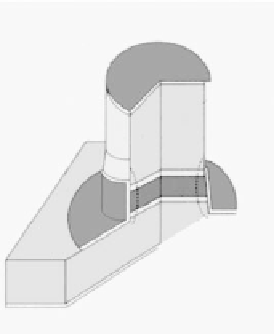Information Technology Reference
In-Depth Information
~0.5
μ
m
Drain
l
Drain
S
Metal
“ion dot”
N
M
Gate
0.8
nm
N
N
N
N
N
(A
−
)
n
Dot
Source
Source
S
Side gate
(a)
(b)
(c)
Figure
12.1.
(a) Schematic representation of a typical semiconductor quantum
dot showing a pillar-like structure with typical dimension of ca. 0.5 mm[8].
(b) By analogy, the same representation exhibiting the concept of a metal ion
dot. The ion dot region has an extension of ca. 0.8 nm as shown in (c) the X-ray
structure of the respective Ruthenium (II) compound [9].
12.1.3. Cellular Automata Based on Molecules
Further interest in molecularly based devices has risen from an alternative encoding
concept called cellular automata (see Chapter 4). Herein, molecules do not act as
0/1 switches but instead as substructured charge containers with changing local
electron density distribution [10]. First envisioned for 2D assemblies of quantum
dots, binary information is encoded in the internal charge distribution of appro-
priated dot ensembles or suited molecules. Such type of molecules should possess a
small number of differently charged redox centers in a geometrically well defined
intramolecular configuration. In case of half-charging, each molecule (here called
''cell'') exhibits degenerated ground states that can be interconverted by changing
external field parameter triggers. Finally, the degeneracy of the ground states of a
single cell/molecule is lifted by the electrostatic interaction with the neighbouring
cells (arranged in 1D, 2D, or even 3D). The removal of the degeneracy results in ''1''
and ''0'' states, which are used for computation in the usual binary way, although
the logic operation depends directly on a structural parameter, i.e., the supramo-
lecular 2D arrangement (Fig. 12.2). The critical parameter of the encoding and
processing of information here is the degree of intramolecular electronic interaction
between the redox centers within the cells: They should be able to communicate, but
be neither completely delocalized nor too localized. Additionally, and perhaps an
even bigger challenge is the fine tuning of the intermolecular, electrostatic
Coloumb interactions between the cells/molecules. Here, surface effects involving

















































Search WWH ::

Custom Search